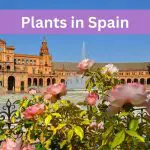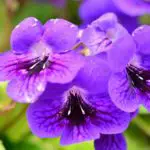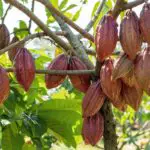Last Updated on February 11, 2023 by Derek
What Are the Main Plants in Italy?
The main plants in Italy are:
- Olive trees
- Grapevines
- Cypress trees
- Lemon trees
- Oak trees
- Pine trees
- Laurel trees
- Magnolia tree
- Lavender
- Sunflowers
The main plants in Italy are cultivated, with the lily being the most popular. The country’s vast farmland, over 25 million acres, supports various herbs, vegetables, and other common plants. Most of them contribute to the country’s staple foods, improving the lifestyle of the residents.
In addition to the food crops, the climate supports the growth of various trees, some wild but mainly cultivated. Native Mediterranean trees and shrubs are also common.
Below are some of the main plants in Italy.
- Wheat (Triticum)
- Corn/maize (Zea mays)
- Potatoes (Solanum tuberosum)
- Sugar beets (Beta vulgaris subsp. vulgaris Altissima)
- Rice (Oryza sativa)
- Holm oak (Quercus ilex)
- Aleppo pine (Pinus halepensis)
- Olive plants (Olea europaea)
- Fig trees (Ficus carica)
- Tomatoes (Solanum lycopersicum L.)
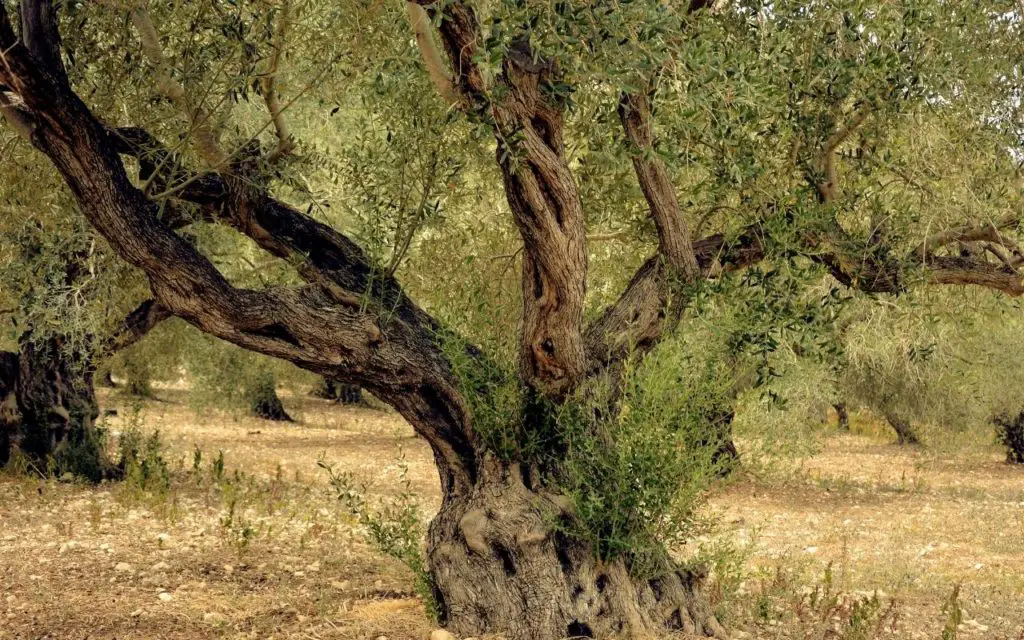
What Are Unique Plants in Italy?
Italy is home to many plant species, thanks to the diverse ecosystems. The Italian peninsula particularly hosts over 6,700 plant species. Apart from being the center for most of the trees in Europe, there are unique species that are exclusively Italian.
Below are some unique plants exclusively growing in Italy.
| Common name | Scientific name | Details |
| Sicilian fir | Abies nebrodensis | It is an evergreen endangered conifer growing in the Madonie mountains and Italy’s nebrodi. It has dark green foliage and no flowers. |
| Italian bellflower | Campanula isophylla | It is a type of bellflower only growing in the Italian Alps. It bears small star-shaped flowers in white and blue shades from spring to fall with its tiny leaves. |
| Marsican Iris | Iris marsica | It displays gorgeous flowers from May to June in the shades of dark violet, dark purple, light blue-violet, and sometimes bears bi-toned blossoms. |
| Margery Fish | lungwort Pulmonaria vallarsae | It is a deciduous perennial with long dark green hairy leaves adorned with whitish or bright dots. Its funnel-like violet blooms appear from early to late spring. |
| Nuragica Columbine | Aquilegia nuragica | It is an herb that is endemic in Italy. It produces showy flowers in late spring or early summer. The white or pale blue blooms attract hummingbirds and bees. |
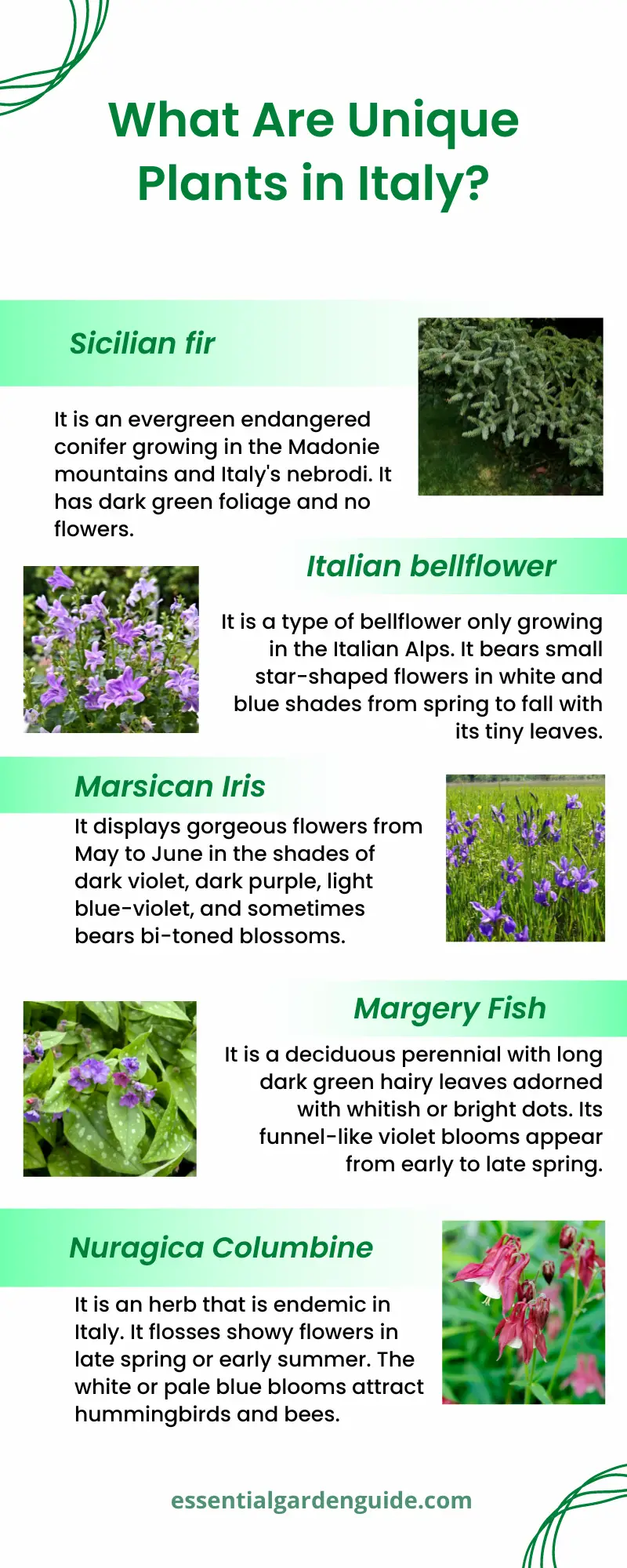
What Are the Purple Flowers in Italy?
Italian lavender (Lavandula stoechas) is a wing-like purple flowering plant native to the coast of Italy. It is an aromatic herb that grows best in hardiness zones 7 to 9. It is ideal for slopes and banks, hedges, screens, edging, beds and borders. It is also suitable for zones 5 to 8 and is common from kitchen gardens to commercial growing fields.
- It thrives in dry to medium, light, well-draining sand, chalk, or loam with acidic, neutral, or alkaline pH. It can flourish in poor soil with excellent air circulation.
- It requires moderate maintenance and low watering and does best in full sun
- Its mature size is 2 to 3 feet tall and 2 to 3 feet wide
- It blossoms from mid-spring to late summer under the right conditions
- It is resistant to rabbits, deer, dry and rocky soils and attracts butterflies and butterflies
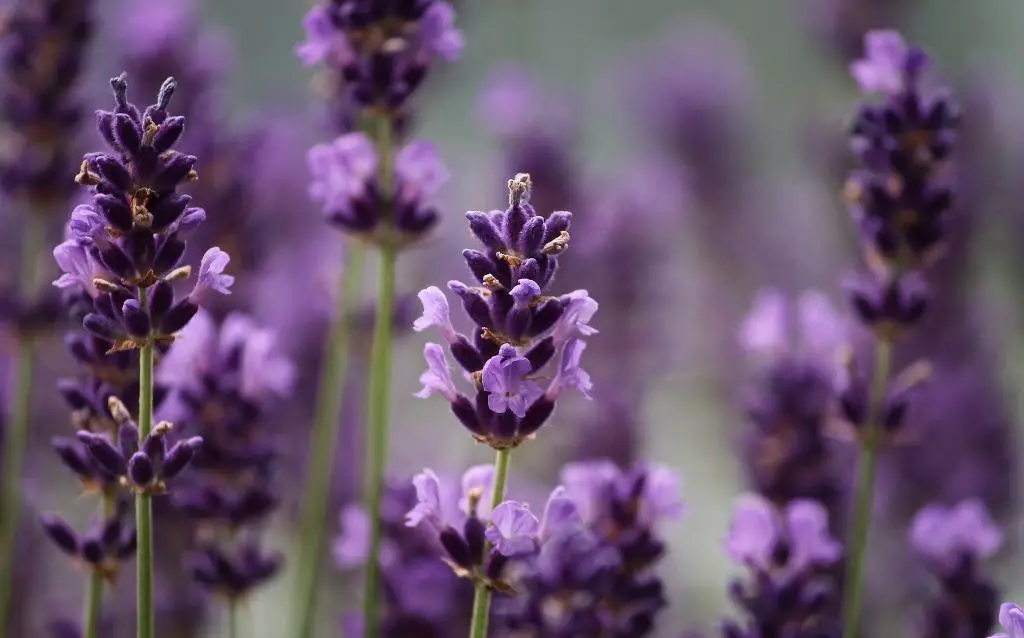
| Common Name | Botanical Name | Soil pH Range | Soil Type | Sunshine | Growing Zones |
|---|---|---|---|---|---|
| Lavender | Lavandula | 6.0 – 7.0 | Well-draining, sandy | Full sun | 5-9 |
10 Types of Italian Plants
Italy’s climate and landscape support the growth of many plants. The vegetation varies from olives, cypresses, common grasses, irises, and hydrangeas to food crops and vegetables.
The following are some of the main common plants and trees in Italy.
1. Aleppo pine (Pinus halepensis)
It is also called Jerusalem pine, and it is a gorgeous evergreen conifer whose adaptations allow it to survive dry and hot conditions. It disperses seeds which makes it invasive. Some people grow it as a live Christmas tree though its main purpose is as an ornamental specimen and screening.
It is particularly common in Calabria.
- A mature tree is 20 feet wide and 20 to 50 feet tall
- It is native to the Mediterranean in hardiness zones 8 to 11
- It can thrive in many soil conditions as long as it is well-draining with acidic, alkaline, or neutral. But its favorite is sand and loam
- It appreciates full sun the whole day
- It is ideal for reducing soil erosion in dry areas as it is drought-tolerant
- It tolerates strong winds and sprays

| Common Name | Botanical Name | Soil pH Range | Soil Type | Sunshine | Growing Zones |
|---|---|---|---|---|---|
| Aleppo Pine | Pinus halepensis | 6.0 – 7.5 | Well-draining | Full sun | 7-11 |
2. Carob tree (Ceratonia siliqua)
It is also known as the locust bean or St. John’s breed. It is an evergreen tree native to the Mediterranean region. Its trunk is thick and twisted and has a brown bark. It is a tough and durable leguminous plant. It flaunts lovely bright green foliage, clusters of gorgeous little blooms, and pods that are edible as substitutes for cocoa powder.
- A mature tree can be 10 meters tall, with exceptional ones reaching 15 meters
- It is a dioecious tree; it produces male and female blossoms.
- It has shiny, oval, dark green leaves 12 to 30 cm long
- It is cold-tolerant, up to -7 degrees Celsius
- It can thrive in difficult sites like poor soils and sloppy hillsides if the soil is loamy or sandy. It can tolerate arid conditions but not wet or acidic soil
- It does best in full sun but requires sheltering from strong winds
Carob is mainly grown for food. It is the best alternative to regular chocolate for the following reasons.
- Antioxidants
- Rich in fiber
- Lower fat and sugar levels
- No caffeine
- It is gluten-free
It is sweeter than regular chocolate, but you can add stevia if you feel it is not sweet enough.

| Common Name | Botanical Name | Soil pH Range | Soil Type | Sunshine | Growing Zones |
|---|---|---|---|---|---|
| Carob Tree | Ceratonia siliqua | 6.0 – 8.0 | Well-draining, fertile | Full sun | 9-11 |
3. Holm oak (Quercus ilex)
It’s a large evergreen tree with a prominent crown and shiny, leathery dark green leaves 7 cm long. It bears clusters of yellow-green female blooms and dangling catkins of male flowers.
- A mature tree can be 12 to 21 meters in height and width
- It is to grow and requires low maintenance
- It performs well in moist, well-draining soil with acidic, neutral, or alkaline pH
- It loves full sun but can survive some shade
- Under the right conditions, it blooms in spring, summer, fall, and winter
- It is resistant to drought and salty conditions
- It is poisonous to horses
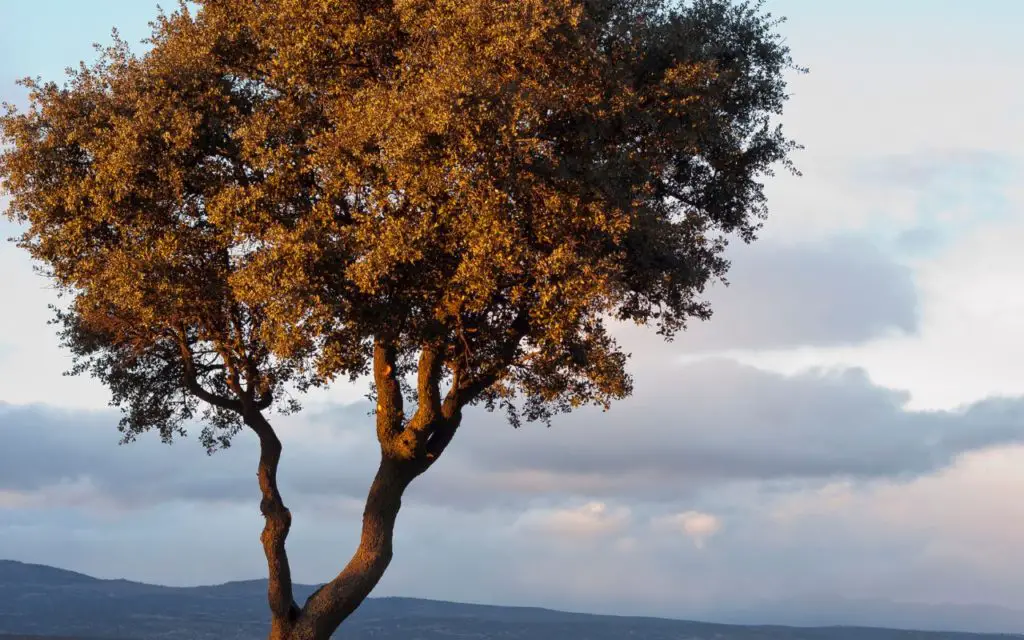
| Common Name | Botanical Name | Soil pH Range | Soil Type | Sunshine | Growing Zones |
|---|---|---|---|---|---|
| Holm Oak | Quercus ilex | 6.0 – 7.0 | Well-draining, adaptable | Full sun | 7-11 |
4. Italian bellflower (Campanula isophylla)
It is also called the Star of Bethlehem, falling stars, among other common names, native to the Italian Alps. It flaunts small, somewhat brittle bright green heart-shaped leaves with toothed edges. It blooms between mid-summer and autumn, and the flowers appear in succession for two months. An individual flower lasts up to 4 days.
- It appreciates well-draining soil with neutral to slightly alkaline soil. You can correct acidity by adding some lime
- It thrives in bright sunlight but not direct sun. the flowers need shading
- It has numerous slender 12-inch stems

| Common Name | Botanical Name | Soil pH Range | Soil Type | Sunshine | Growing Zones |
|---|---|---|---|---|---|
| Italian Bellflower | Campanula ‘Italian Bellflower’ | 6.0 – 7.5 | Well-draining, moist | Partial sun to partial shade | 4-8 |
5. Italian lavender (Lavandula stoechas)
It is a perennial shrub mainly recognizable by its purple flowers and conspicuous bracts. Most of its growers love it for its aromatic leaves that produce essential oils. It requires average maintenance and low watering.
- A mature plant is 2 to 3 ft height and width
- It prefers well-drained soil with acidic, neutral, or alkaline pH
- It does best in full sun
- It flowers from mid-spring to late summer
- It is native to hardiness zones 8 to 9
- It is deer, drought, rabbit, dry, and rocky soil tolerant
6. Mastic tree (Pistacia lentiscus)
It can be a large evergreen tree or shrub with tiny, green, aromatic leaves. It is a dioecious plant whose sap makes air fresheners and its flowers are showy and fragrant.
- It grows 4-8 meters tall and 6-9 meters wide
- It loves well-drained loam or sand with acidic, neutral, or alkaline pH
- It blossoms in full sun
- It flowers in spring, summer, fall, and winter

| Common Name | Botanical Name | Soil pH Range | Soil Type | Sunshine | Growing Zones |
|---|---|---|---|---|---|
| Mastic Tree | Pistacia lentiscus | 6.0 – 8.0 | Well-draining, rocky | Full sun | 7-10 |
7. Oleander (Nerium oleander)
It grows naturally as a round bush, but you can trim it to a tiny tree. It has evergreen leathery dark green foliage excellent for privacy if grown in borders.
- Its height is 8-12 feet, with some compact species growing up to 3-4 feet tall
- It is adapted to fertile, well-drained, alkaline soil
- It is native to the Mediterranean and zones 8-10
- It flowers from spring to summer
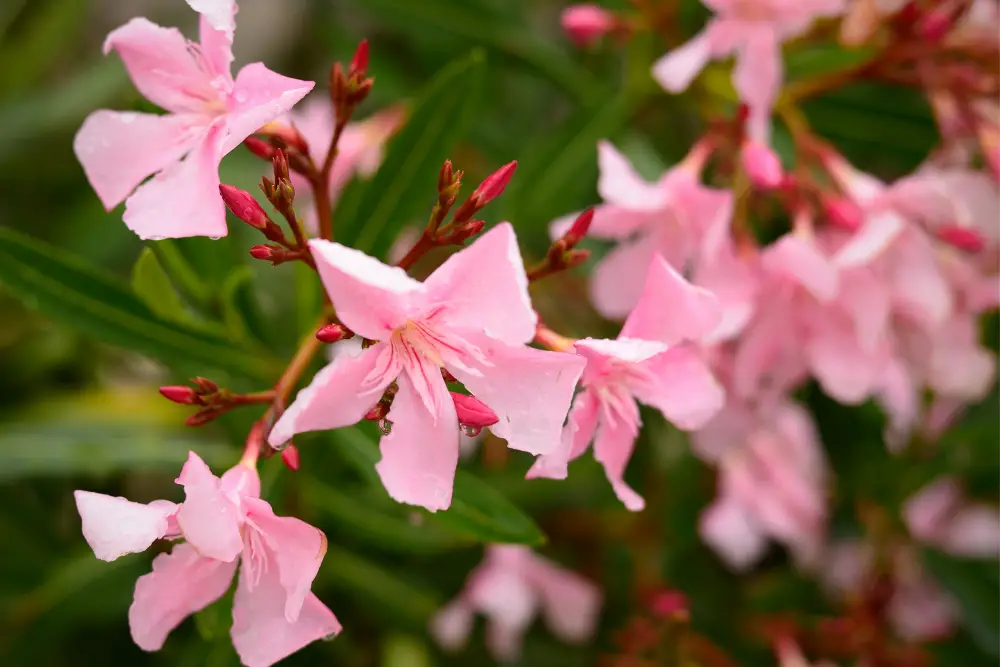
| Common Name | Botanical Name | Soil pH Range | Soil Type | Sunshine | Growing Zones |
|---|---|---|---|---|---|
| Oleander | Nerium oleander | 6.0 – 7.5 | Well-draining, tolerant of various soil types | Full sun | 8-11 |
8. The olive tree (Olea europaea)
It is an evergreen tree with a gnarled trunk, spreading crown, and silvery foliage. It has 2-3-inch grey-green leaves and tiny white flowers.
- It grows 6-9 meters in height and width
- It is best grown in well-drained soil with acidic, alkaline, or neutral pH and full sun
- It is drought-resistant
- It displays showy flowers in spring, summer, fall, and winter
- It bears edible olives
9. Rosemary (Salvia rosmarinus)
It is an intensely aromatic evergreen shrub with needle-like 1-inch-long leaves. Its clusters of pale blue to white blooms appear in winter and spring.
- It can attain 2-6 feet in height and 2-5 feet in width
- It appreciates best moist, well-drained soil with a neutral, acidic, or alkaline pH
- It needs full sun to bloom in spring, summer, winter
- The bright, fragrant flowers attract butterflies and bees, and hummingbirds
- It is rabbit, drought, and deer-tolerant
Rosemary has several uses and benefits.
- It boosts memory
- Improving the circulation and immune system
- It improves growth

| Common Name | Botanical Name | Soil pH Range | Soil Type | Sunshine | Growing Zones |
|---|---|---|---|---|---|
| Rosemary | Rosmarinus officinalis | 6.0 – 7.0 | Well-draining, rocky soil | Full sun | 8-10 |
10. Sicilian fir (Abies nebrodensis)
It is an evergreen conifer mostly grown for its foliage in winter. The mature tree can be 6-9 meters tall with blue-green foliage but does not bear any flowers.
- It grows best in well-drained soil with acidic (5.6-6.0) or mildly acidic (6.1-6.5) pH
- It does well in full sun
- It is tolerant to drought
- It requires average but regular watering to flourish.

| Common Name | Botanical Name | Soil pH Range | Soil Type | Sunshine | Growing Zones |
|---|---|---|---|---|---|
| Sicilian Fir | Abies nebrodensis | 5.0 – 7.0 | Well-draining, moist | Full sun to partial shade | 7-9 |


